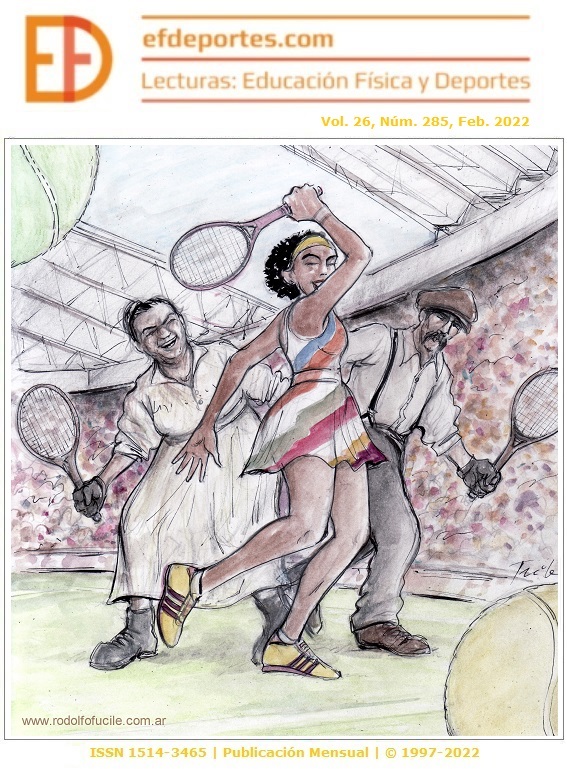HIIT Training to Enhance VO2 max in Marines on Small Vessels
Abstract
Introduction: During the last decade, high intensity interval training, mostly known as HIIT, has been positioned in the different sports training as a healthy alternative at a cardio-muscular level, standing out mainly in the rapid increase in VO2 max in athletes who perform these workouts. Despite its great utility, at present there is no program for its application in small vessel seafarers. Objective: To enhance VO2 max in sailors of smaller vessels, using HIIT training. Methods: descriptive-correlational research, selecting under a non-probabilistic intentional sampling 70 marine from smaller boats (male gender; 35-38 years old), who will undergo HIIT training, assessing their aerobic capacity in two moments. Results: There are notable improvements in the time used to complete the 2-mile test in post-test favor (Pretest: 16:54 minutes, Posttest: 15:20 minutes; p=0.000), significantly increasing VO2 max in the second moment of test implementation (Pretest: 29.19, Posttest: 38.66; p=0.000). Conclusions: Interval training demonstrated favorable results to significantly improve VO2 max in marine of small vessels, demonstrating potential for the aerobic endurance development, assuming that the usual methods of conditioning in naval deliveries can be changed. However, in the future it is recommended to establish quasi-experimental research with independent groups, which will determine whether HIIT in comparison with the traditional Ecuadorian marine training method to enhance aerobic endurance capacity, optimizes to a greater or equal degree.
References
Bassett, D.R., y Howley, E.T. (2000). Limiting factors for maximum oxygen uptake and determinants of endurance performance. Medicine and science in sports and exercise, 32(1), 70-84. https://doi.org/10.1097/00005768-200001000-00012
Batacan, R.B., Duncan, M.J., Dalbo, V.J., y Tucker, P.S. (2017). Effects of high-intensity interval training on cardiometabolic health: a systematic review and meta-analysis of intervention studies. British journal of sports medicine, 51(6), 494-503. https://doi.org/10.1136/bjsports-2015-095841
Calero-Morales, S., Alvarado, C., Carlos, R., Morales-Pillajo, C.F., Vilatuña, V., Maciel, A., y Fernández-Concepción, R.R. (2017). Efectos de la hipoxia en atletas paralímpicos con entrenamiento escalonado en la altura. Revista Cubana de Investigaciones Biomedicas, 36(1), 1-12. http://www.revibiomedica.sld.cu/index.php/ibi/article/view/36/34
Callahan, E. (2019). Understanding and Overcoming the Challenge of Obesity and Overweight in the Armed Forces: Proceedings of a Workshop. National Academies Press.
Cevallos, J. (2018). Reglamento de Cultura Física. Ministerio de Defensa del Ecuador.
Clavijo, J.P., Morales, S.C., y Cárdenas, H. (2016). Análisis comparativo de las pruebas físicas del personal naval, región costa y sierra. Revista Cubana de Medicina Militar, 45(4), 1-15. https://www.researchgate.net/publication/317040673
Curiel-Regueros, A., Fernández-Lucas, J., y Clemente-Suárez, V.J. (2019). Effectiveness of an applied high intensity interval training as a specific operative training. Physiology & behavior, 201, 208-211. https://doi.org/10.1016/j.physbeh.2019.01.009
Di Battista, A.P., Moes, K.A., Shiu, M.Y., Hutchison, M.G., Churchill, N., Thomas, S.G., y Rhind, S.G. (2018). High-intensity interval training is associated with alterations in blood biomarkers related to brain injury. Frontiers in physiology, 9(1367), 1-10. https://doi.org/10.3389/fphys.2018.01367
García, G.C., Secchi, J.D., y Arcuri, C.R. (2016). Relación entre las velocidades finales alcanzadas en los test UMTT y UNCa en sujetos masculinos. Apunts. Medicina de l'Esport, 51(190), 48-54. https://doi.org/10.1016/j.apunts.2015.11.002
Gibala, M.J., Hawley, J.A., Little, J.P., y MacDonald, M.J. (2013). Adaptaciones Fisiológicas al Entrenamiento Intervalado de Alta Intensidad y Bajo Volumen en la Salud y la Enfermedad-International Endurance Group. PubliCE, 0, 1-17.
Guevara, P.V., y Morales, S.(2017). La técnica de carrera y el desarrollo motriz en aspirantes a soldados. Revista Cubana de Investigaciones Biomédicas, 36(3), 1-14. http://www.revibiomedica.sld.cu/index.php/ibi/article/view/12
Klymovych, V., Oderov, A., Romanchuk, S., Korchagin, M., Zolochevskyi, V., Fedak, S., y Lesko, O. (2020). Correlation of Physical Fitness and Professional Military Training of Servicemen. Sport Mont, 18(2), 79-82. https://doi.org/10.26773/smj.200612
Kyröläinen, H., Pihlainen, K., Vaara, J.P., Ojanen, T., y Santtila, M. (2018). Optimising training adaptations and performance in military environment. Journal of Science and Medicine in Sport, 21(11), 1131-1138. https://doi.org/10.1016/j.jsams.2017.11.019
Larrea, B., y Morales, S. (2017). El rendimiento aeróbico del personal militar femenino en menos de 500 y más de 2000 m snm. Revista Cubana de Investigaciones Biomédicas, 36(3), 1-10. http://www.revibiomedica.sld.cu/index.php/ibi/article/view/84
López-Chicharro, J., y Vicente-Campos, D. (2018). HIIT entrenamiento interválico de alta intensidad: bases fisiológicas y aplicaciones prácticas. Exercise Physiology and Tranining, Ed.
Morocho, H.G., Tulcanaza, J., y Guerrero, P.M. (2021). Entrenamiento interválico de Alta Intensidad para mantener VO2max en cadetes de tercer año de la ESMIL. Polo del Conocimiento: Revista científico-profesional, 6(3), 788-799. https://polodelconocimiento.com/ojs/index.php/es/article/view/2403/html
Nieto, C., y Cárcamo, M. (2016). Entrenamiento y evaluación de la capacidad física militar. Revisión de la literatura. Revista española de educación física y deportes, 415, 75-86. https://www.reefd.es/index.php/reefd/article/view/508
Oliveira, D.R., da Costa Mesquita, M.L., de Azevedo, N.A., y de Oliveira Rocha, A.W. (2018). Musculação e HIIT: uma proposta válida no tratamento da obesidade. Lecturas: Educación física y deportes, 23(241), 124-132. https://www.efdeportes.com/efdeportes/index.php/EFDeportes/article/view/112
Rivadeneyra Carranza, P.E., Morales, S., y Parra Cárdenas, H.A. (2017). Estudio del VO2máx en soldados entrenados en menos de 500 y más de 2000 m snm. Revista Cubana de Investigaciones Biomédicas, 36(2), 12-28. http://www.revibiomedica.sld.cu/index.php/ibi/article/view/4
Tornero-Aguilera, J.F., Pelarigo, J.G., y Clemente-Suárez, V.J. (2019). Psychophysiological intervention to improve preparedness in military special operations forces. Aerospace medicine and human performance, 90(11), 953-958. https://doi.org/10.3357/AMHP.5385.2019
Véliz, C.V., Cid, F.M., Páez, M.J., y González, C.M. (2016). Efectos de un entrenamiento interválico de alta intensidad (HIIT) sobre el VO2máx y la recuperación intermitente en jóvenes nadadores. EmásF: revista digital de educación física, 7(39), 48-57. https://www.researchgate.net/publication/295253833
Vogt, D., King, M.W., Borowski, S., Finley, E.P., Perkins, D.F., y Copeland, L.A. (2021). Identifying factors that contribute to military veterans’ post‐military well‐being. Applied Psychology: Health and Well‐Being, 13(2), 341-356. https://doi.org/10.1111/aphw.12252
Wang, C. (2020). Study on the Organic Integration of High Intensity Interval Training Regime and Physical Fitness Training of Special Operation Forces. International Conference on Man-Machine-Environment System Engineering, 645, 857-865. https://doi.org/10.1007/978-981-15-6978-4_98
Copyright (c) 2022 Lecturas: Educación Física y Deportes

This work is licensed under a Creative Commons Attribution-NonCommercial-NoDerivatives 4.0 International License.








